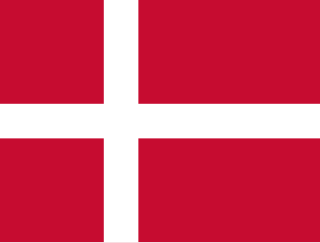
The national flag of Denmark is red with a white Nordic cross, which means that the cross extends to the edges of the flag and the vertical part of the cross is shifted to the hoist side.

The Flag of Europe or European Flag consists of twelve golden stars forming a circle on a blue field. It was designed and adopted in 1955 by the Council of Europe (CoE) as a symbol for the whole of Europe.

The flag of Greenland was designed by Greenland native Thue Christiansen. It features two equal horizontal bands of white (top) and red (bottom) with a counter-changed red-and-white disk slightly to the hoist side of centre. The entire flag measures 18 by 12 parts; each stripe measures 6 parts; the disk is 8 parts in diameter, horizontally offset by 7 parts from the hoist to the centre of the circle, and vertically centered.

A national flag is a flag that represents and symbolizes a given nation. It is flown by the government of that nation, but usually can also be flown by its citizens. A national flag is typically designed with specific meanings for its colours and symbols, which may also be used separately from the flag as a symbol of the nation. The design of a national flag is sometimes altered after the occurrence of important historical events. The burning or destruction of a national flag is a greatly symbolic act.

The national flag of Sweden consists of a yellow or gold Nordic cross on a field of light blue. The Nordic cross design traditionally represents Christianity. The design and colours of the Swedish flag are believed to have been inspired by the present coat of arms of Sweden of 1442, which is blue divided quarterly by a cross pattée of gold, and modelled on the Danish flag. Blue and yellow have been used as Swedish colours at least since Magnus III's royal coat of arms of 1275.

The flag of Finland, also called siniristilippu, dates from the beginning of the 20th century. On a white background, it features a blue Nordic cross, which represents Christianity.

The flag of Estonia is a tricolour featuring three equal horizontal bands of blue (top), black (middle), and white (bottom). In Estonian it is colloquially called the sinimustvalge.

The national flag of Norway is red with a navy blue Scandinavian cross fimbriated in white that extends to the edges of the flag; the vertical part of the cross is shifted to the hoist side in the style of the Dannebrog, the flag of Denmark.

Three Crowns is the national emblem of Sweden, present in the coat of arms of Sweden, and composed of three yellow or gilded coronets ordered two above and one below, placed on a blue background. Similar designs are found on a number of other coats of arms or flags.

The flag of the Faroe Islands is an offset cross, representing Christianity. It is similar in design to other Nordic flags – a tradition set by the Dannebrog of Denmark, of which the Faroe Islands are an autonomous territory.

The flag of Iceland was officially described in Law No. 34, set out on 17 June 1944, the day Iceland became a republic. The law is entitled "The Law of the National Flag of Icelanders and the State Arms" and describes the Icelandic flag as follows:
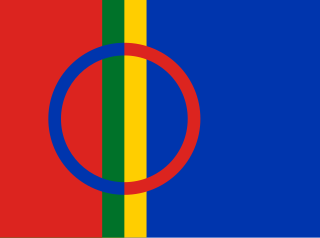
The Sámi flag is the flag of Sápmi and the Sámi people, one of the indigenous people groups of the Nordic countries and the Kola Peninsula of the Russian Federation.

A roundel is a circular disc used as a symbol. The term is used in heraldry, but also commonly used to refer to a type of national insignia used on military aircraft, generally circular in shape and usually comprising concentric rings of different colours. Other symbols also often use round shapes.
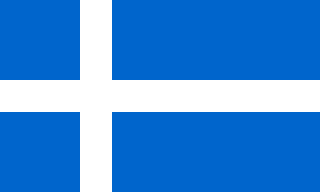
The flag of Shetland is a white or silver Nordic cross on a blue background. The flag uses the colours of the flag of Scotland, but in the form of the Nordic cross in order to symbolise Shetland's historical and cultural ties with Scandinavia. The official recommended colour of the flag of Scotland is Pantone 300, which implies that this would be appropriate for the Shetland flag too, though the Flag Institute lists the colour as a similar Pantone 286. It was created by Roy Grønneberg and Bill Adams in 1969, to commemorate the 500th anniversary of the transfer of the islands from Norway in the Kalmar Union to Scotland and the 500 years before as part of Norway.

The Flag of Orkney was the winner of a public flag consultation in February and March 2007. In the flag consultation the people of Orkney were asked for their preferred design from a short list of 5, all of which had been approved by the Court of the Lord Lyon. The chosen design was that of Duncan Tullock of Birsay, which polled 53% of the 200 votes cast by the public.
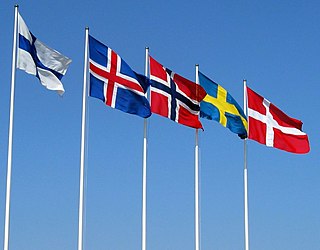
A Nordic cross flag is a flag bearing the design of the Nordic or Scandinavian cross, a cross symbol in a rectangular field, with the centre of the cross shifted towards the hoist.
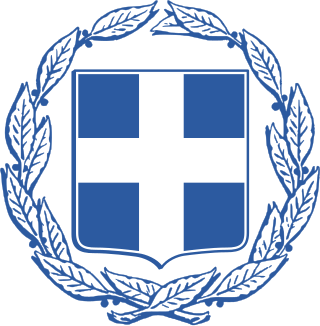
The coat of arms of Greece or national seal of Greece comprises a white Greek cross on a blue escutcheon, surrounded by two laurel branches. It has been in use in its current form since 1975. Prior to the adoption of the current coat of arms, Greece used a number of different designs, some of which were not heraldic; the first heraldic design was introduced in 1832 and its main element, the blue shield with the white cross, has been the base for all other national coats of arms since then. The design is a heraldic representation of the Greek national flag adopted in 1822, which featured a white cross on a blue field.

The flag of the Swedish-speaking Finns is an unofficial red flag with a yellow cross used in the Swedish-speaking parts of Finland to represent the Finland-Swedes. It may be flown in addition to the Finnish blue and white flag. This flag is unfamiliar to many in Finland but there have been attempts to introduce it again to a broader audience as what is known as "household pennants" demonstrating one's identity as Swedish-speaking, are more common and can be seen on many flagpoles in areas where there live many Swedish-speaking Finns, especially in countryside.

The Nordic Ecolabel or Nordic swan is the official sustainability ecolabel for products from the Nordic countries. It was introduced by the Nordic Council of Ministers in 1989. The logo is based on the logo of the Nordic Council adopted in 1984 which symbolises trust, integrity and freedom. The Nordic Swan covers 67 different product groups, from hand soap to furniture to hotels.
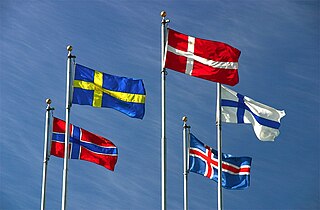
Flag families are sets of national flags with similarities in their design, often based on a shared history, culture, or influence. Families do not include flags with coincidental similarities. Flags may be in multiple flag families. Only twelve current national flags existed before the 19th century, when large-scale flag use began. Seven of these flags are the inspiration for more than 130 current national flags and ensigns.























